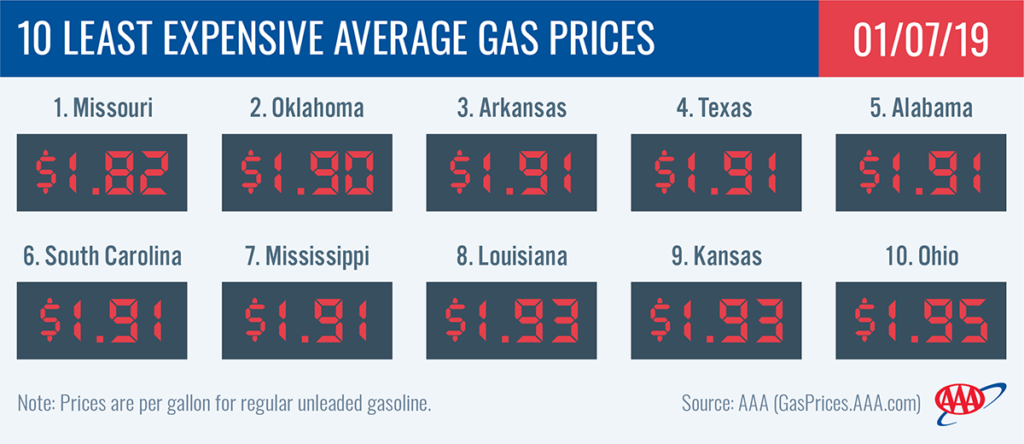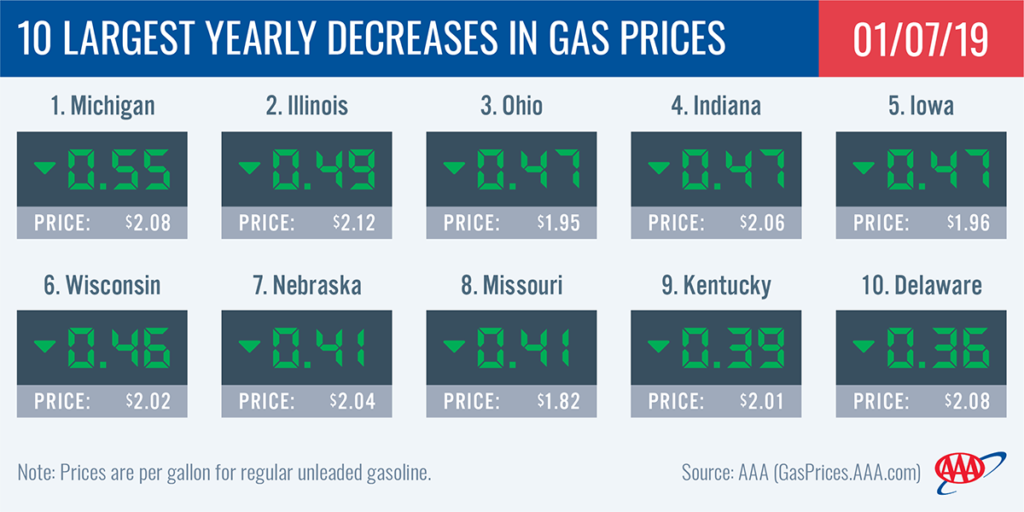The latest Energy Information Administration (EIA) data registers gasoline demand at 8.6 million b/d for the week ending December 28 – the lowest level on record since February 2017. Despite record motor vehicle travel for the holiday, demand was down nearly 900,000 bbl, suggesting that demand this winter could be lower than expected.
Today’s national gas price average is $2.24 and has declined for 12 weeks in a row. The national average is three-cents cheaper on the week, 20-cents cheaper than last month and 25-cents cheaper year-over-year.
“As the global crude market continues to be oversupplied, oil prices are dropping, continuing last week’s trend,” said Jeanette Casselano, AAA spokesperson. “This is good news for motorists filling up at the pump.”
Quick Stats
- The nation’s top 10 least expensive markets are: Missouri ($1.82), Oklahoma ($1.90), Arkansas ($1.91), Texas ($1.91), Alabama ($1.91), South Carolina ($1.91), Mississippi ($1.91), Louisiana ($1.93), Kansas ($1.93), and Ohio ($1.95).
- The nation’s top 10 yearly decreases are: Michigan (-55 cents), Illinois (-49 cents), Ohio (-47 cents), Indiana (-47 cents), Iowa (-47 cents), Wisconsin (-46 cents), Nebraska (-41 cents), Missouri (-41 cents), Kentucky (-39 cents), and Delaware (-36 cents).
Rockies
Motorists in Montana (-9 cents), Colorado (-7 cents), Utah (-6 cents), and Wyoming (-5 cents) saw the largest weekly decreases in the country. With the declines, state gas price averages are inching toward all being close to or below the $2.50 mark: Utah ($2.55), Wyoming ($2.54), Idaho ($2.53), Montana ($2.33), and Colorado ($2.20).
With regional refinery utilization jumping six percent on the week, gasoline stocks increased 252,000 bbl. The EIA reports that gasoline stocks for the region register at 7.2 million bbl. Historically, the region sees stocks build throughout Q1 ahead of peak summer tourism season.
Great Lakes and Central
This week, nine Great Lakes and Central states land on the top 10 list of largest year-over-year difference in gas prices in the country: Michigan (-55 cents), Illinois (-49 cents), Ohio (-47 cents), Indiana (-47 cents), Iowa (-45 cents), Wisconsin (-46 cents), Nebraska (-41 cents) Missouri (-41 cents) and Kentucky (-39 cents).
This week, gas prices in the region range from $2.20 in North Dakota to $1.82 in Missouri.
Gasoline inventories continued to build, adding 1.2 million bbl. This trend is expected to continue into the early half of the year. At 54.2 million bbl, stocks are at a 3.5 million bbl year-over-year surplus.
South and Southeast
The seven South and Southeast states that are among the top 10 cheapest in the country this week are the same as this time last year, but the year-over-year price differential is eye-opening: Arkansas (-41 cents), Oklahoma (-36 cents), Mississippi (-35 cents), Louisiana (-35 cents), South Carolina (-34 cents), Alabama (-34 cents) and Texas (-34 cents).
This week’s largest build of gasoline stocks was seen in the South and Southeast region. With the addition of 3.5 million bbl, total stocks measure at 89.2 million bbl – an all-time record according to EIA data.
Mid-Atlantic and Northeast
On the week, gas prices only dropped three to five cents across all Mid-Atlantic and Northeast states. Connecticut ($2.58), New York ($2.58) and Washington, D.C. ($2.55) carry the most expensive gas price averages in the region and land on the top 10 list of most expensive states in the country, which was also the case last year. However, today’s averages are as much as 15 cents cheaper than at the same time in 2018.
The latest EIA data shows gasoline stocks built by 724,000 bbl. Analysts speculate this was a low build for the region and partially due to low import rates on the week. Total stocks now sit at 61 million bbl.
West Coast
Motorists in the West Coast region continue to pay the highest pump prices in the nation, with all of the region’s states landing on the nation’s top 10 most expensive list. California ($3.32) is the nation’s most expensive market, followed by Hawaii ($3.30), Washington ($3.05), Alaska ($3.01), Oregon ($2.91), Nevada ($2.92) and Arizona ($2.63). While expensive, prices are decreasing, with all state averages moving lower on the week: Hawaii (-6 cents) and Washington (-6 cents) saw the largest drops.
EIA’s recent weekly report showed that West Coast gasoline stocks increased by approximately 1.2 million bbl to 28.3 million bbl. Stocks are approximately 4.6 million bbl lower than at this time last year, which could cause prices to spike if there is a supply challenge in the region this week.
Oil market dynamics
At the close of Friday’s formal trading session on the NYMEX, WTI increased 87 cents to settle at $47.96. Oil prices were volatile last week, as market observers continue to believe that the global crude market is oversupplied. Moreover, analysts are also wary of the impact a potential economic slowdown in 2019 could have on global crude oil demand. In the coming weeks, market observers will look for indications that OPEC’s global pact with large non-OPEC crude producers (including Russia) will reduce crude production by 1.2 million b/d for at least the first six months of 2019, which may help reduce the growing global glut of crude. In turn, this could drive up crude oil prices and, subsequently, gas prices.
In related news, EIA’s latest weekly petroleum status report revealed that total domestic crude inventories held steady for the second week at 441.4 million bbl. Domestic crude production also held steady for a second week at a record high of 11.7 million b/d. Steady inventories amid high production underscore how oversupplied the market currently is, while demand for gasoline remains at a two-year low. Additionally, Baker Hughes, Inc. reported that the U.S. lost eight oilrigs last week, bringing the current total of active oilrigs to 877. When compared to the total number of active rigs at this time last year, there are 135 more rigs this year.
Motorists can find current gas prices along their route with the free AAA Mobile app for iPhone, iPad, and Android. The app can also be used to map a route, find discounts, book a hotel and access AAA roadside assistance. Learn more at AAA.com/mobile.


